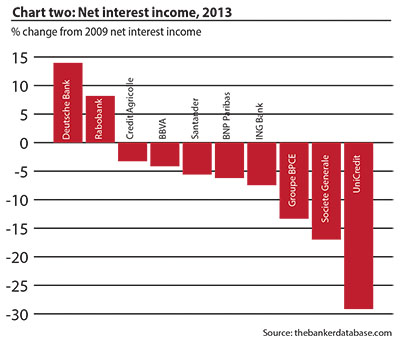Squeezing income: the impact of QE on interest income
Quantitative easing, the long-awaited European Central Bank initiative, has finally arrived. The programme might spell narrower interest margins for European banks, but Deutsche Bank and Rabobank have both managed to increase their net interest incomes.
In January 2015, the European Central Bank (ECB) declared that it will follow in the footsteps of the US Federal Reserve and the Bank of England and embark on a programme of quantitative easing (QE). The central bank has surprised the financial word with the scale of the programme – €60bn-worth of securities will be purchased monthly until at least September 2016, and possibly longer if inflation in the eurozone does not rise to the targeted 2%.
Such large-scale asset purchases will lead to an upturn in bond prices and consequently lower yields. This is the point of the programme, as QE aims to spur the flagging European economy by driving down interest rates, which encourages lending.
However, unless banks are able to optimally adjust their business models, they might see their net interest incomes start to diminish. In principle, banks are dependent for profit on being able to charge higher interest rates on loans than deposits. Upset the margins and the incomes might waver.
Coping so far
Eurozone lenders have already been directly exposed to a small-scale ECB programme of asset purchases and, indirectly, to two QE programmes – in both US and the UK. According to the ECB, net interest incomes of eurozone’s domestic banks have decreased during that time, from €343.53bn in 2009 to €304.55bn in 2013. This might have been expected – in 2012, a research paper by global consultancy McKinsey showed that while net interest margins increased among US banks during QE, due to high demand for deposits, they decreased in Europe, as banks found themselves unable to push the rates paid on deposits sufficiently downwards.
The eurozone’s largest banks have likewise experienced falling net interest incomes. Of the top 10, only Rabobank and Deutsche Bank have been able to earn more interest income in 2013 than in 2009. These two were also the only ones that increased their loan portfolios while maintaining nearly the same levels of funding.
This is an interesting result, given very different business models and locations of the two institutions.
Deutsche Bank is headquartered in Germany, which has experienced a large, €6.03bn drop in interest income due to a low-interest-rate environment. However, the bank has still managed to grow its interest income, by €1.8bn since 2009. It is also less dependent on interest income than most of its peers and with a loan-to-deposit (LTD) ratio of only 72%, it is much better funded.
Rabobank, on the other hand, is located in Netherlands, where banks have successfully staved off interest rate pressures – net interest income has increased for its banks by €910m since 2009. It is more reliant on interest to provide for its income, as it constitutes 69% of the total operating income and, at 145%, it has higher LTD ratio than any of its peers. However, its assets appear to be of sound quality as its non-performing loans are only 2.9%, below the average of the top 10.
Spanish lender Santander is a notable case, as it managed to maintain high net interest incomes until 2013, thanks to its Latin American operations. However, in 2013 it dropped by €2.9bn in the course of one year, as its flagship branch in Brazil was subject to a €2.4bn interest income decrease.
Of the banks that have seen their interest incomes wane, UniCredit has suffered the largest reduction, of €5.19bn, reflecting heavy indebtedness of Italian firms. However, UniCredit’s reliance on interest income has dropped 10 percentage points, to 49% since 2009, making it less vulnerable to further interest rate pressures.
Additionally, banks that are most dependent on interest as part of their income have not been able to make that branch of their business grow. For ING, net interest constitutes 78% of its total income and yet the bank has seen it drop by almost €964m since 2009. This was also the case for BBVA, which depends on interest to provide for 76% of its total income. The bank has seen its interest income decrease by €602m since 2009, although it has still managed to rebound from its lowest point in 2011, when the drop from 2009 amounted to €2.3bn.
The data for this story was sourced from www.thebankerdatabase.com.




